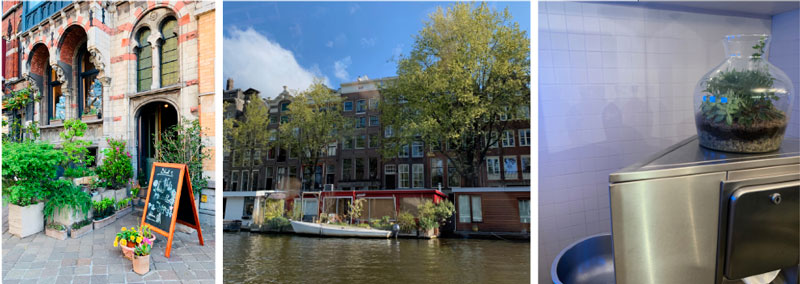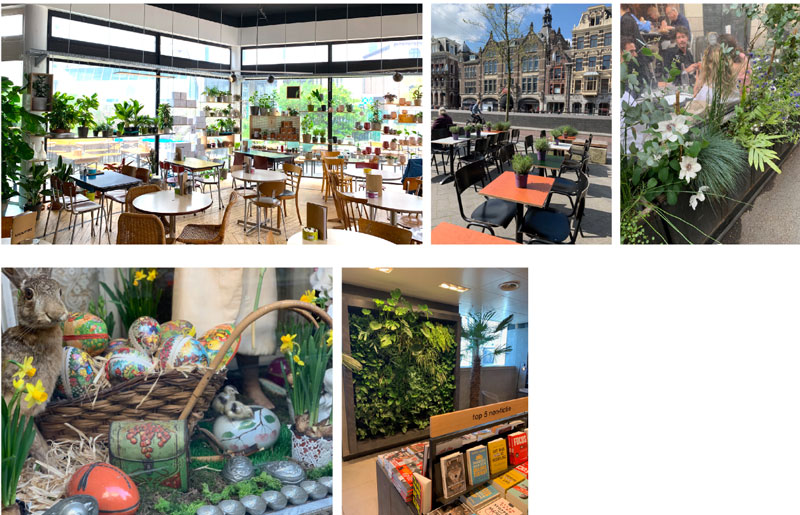8/1/2019
Study Abroad
Katie Elzer-Peters
In April 2019, I was fortunate enough to take a bucket list trip to the Netherlands, Belgium and to Paris, France. My mom wanted me to see the tulips for my 40th birthday and they were spectacular. I’ll never forget seeing the fields in bloom and strolling through the Keukenhof gardens.
What really struck me, though, were the myriad of ways that horticulture was integrated into daily life, probably without overthinking it. The number of and quality of plant displays I saw at non-garden center shops and restaurants leads me to believe that somebody is making it easy for places to use plants in their displays. In fact, while eating at a Cafe in Paris, I saw someone walk across the street from a little flower shop with a new arrangement for the hostess stand. It made me think, “How can we take some of what they do over there and use it over here to integrate plants into daily life more?”
Garden Anywhere
Whether someone had a half acre or 3 square feet, people gardened—that means they could get the plants, of appropriate size for their space, and info about caring for them. In Middelburg, a small city in the Netherlands, there was a pop-up florist/garden center in the town square. Are there opportunities for pop-up markets here? Opportunities to serve others who participate in pop-up markets or farmers markets? (A tip: If you’re not up to speed on compact ornamentals and edibles, Jessica Walliser’s new book, “Gardener’s Guide to Compact Plants” from Quarto Publishing will be amazingly helpful to you.)

Pictured: • One example of a small “garden center” and florist is this operation in the center of Ghent. The price for a small tree in a container: $350 euros.
• Another example of “anywhere horticulture” are these gardens spotted in the canals of Amsterdam.
• “Why are you taking a PICTURE, Katie?” asked my Mom when I was in the bathroom outside the Rijksmuseum in the Netherlands. “They have a terrarium on top of the hand-washing station!”
Make it Easy to Buy and Be Successful
In the United States, a lot of gift retailers have terrarium kits or seed bombs or “tea garden kits,” but I don’t often see kits at garden centers. Maybe we assume that people coming to us know what they’re doing, but I think kits have a place at IGCs. There’s a reason other retailers are selling them—they make money from them. IGCs could buy kits or assemble their own and market that the kits are exclusive to the IGC. A bit of jute twine, brown paper and a container and you have a rustic kit package.

Pictured: We spotted these kits at one of the public gardens we visited.
• I loved this plant tag that showed how easy it would be to plant this clematis.
Partner Up
At MANTS in January, I talked to two different groups running container planting subscription services. In Europe, I saw plants routinely used in ways that would lend themselves to partnership opportunities and market expansion. Now, I know these aren’t traditional revenue models I’m proposing, but thinking outside the box and providing unique services are two ways IGCs can differentiate themselves.
 Pictured: In Antwerp, there was legitimately a restaurant that was half restaurant/café, half garden center. Not pictured is the huge kitchen and counter order section. This concept was fascinating to me. The only other place I’ve seen a food/plant combo on this level is within Molbak’s in Washington State.
Pictured: In Antwerp, there was legitimately a restaurant that was half restaurant/café, half garden center. Not pictured is the huge kitchen and counter order section. This concept was fascinating to me. The only other place I’ve seen a food/plant combo on this level is within Molbak’s in Washington State.
• If there was a café, you could bet there was a potted plant on the tables, even if the table was 18 in. by 18 in. What about a service to deliver fresh pots to restaurants twice a month?
• Higher-end restaurants had incredibly intricate planters to separate the outdoor eating areas from the street. How about a seasonal refresh service with a referral to a trusted weekly maintenance firm for a cut?
• Both of these photos are taken in department stores. The living wall is in de Bijenkorf, the big store in Amsterdam, the terrariums are at Le Bon Marché in Paris. They had a large pop-up terrarium shop inside for the spring. Yet another place I didn’t think to look for plants.
These are just a few examples of “plants are everywhere” that got my wheels turning. Maybe you’ll see the photos and spark a new idea for how to integrate horticulture into your customers’ lives. GP
Katie Elzer-Peters is a garden writer and owner of The Garden Of Words, LLC, a marketing and PR firm handling mostly green industry clients. Contact her at Katie@thegardenofwords.com or at www.thegardenofwords.com.